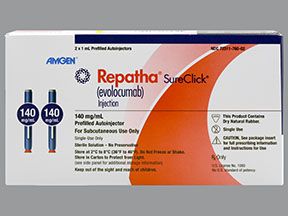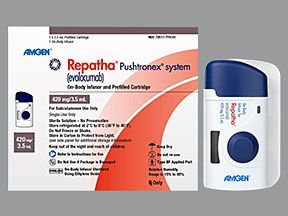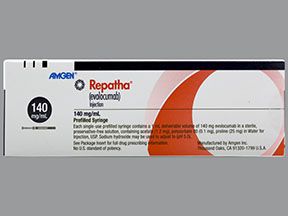Repatha (evolocumab) is a brand-name prescription medication. The Food and Drug Administration (FDA) has approved it to:
- decrease the risk of heart attack, stroke, and the need for certain surgeries in adults with cardiovascular disease
- reduce low-density lipoprotein (LDL) cholesterol in certain adults and children ages 10 years and older
For some uses, Repatha is prescribed in combination with a heart-healthy diet and other cholesterol-lowering therapies. Repatha belongs to a class of biologic drugs called PCSK9 inhibitors. It comes as a solution that you’ll administer by subcutaneous injection. Repatha isn’t available in a biosimilar form.
For information about the dosage of Repatha, including its strengths and how to take it, keep reading. For a comprehensive look at Repatha, see this article.
This article describes typical dosages for Repatha provided by the drug’s manufacturer. When taking Repatha, always follow the dosage prescribed by your doctor.
Commonly recommended dosages for Repatha are shown below. However, your doctor will prescribe the Repatha dosage that’s right for you.
Repatha forms
Repatha comes as a solution that you’ll administer by subcutaneous injection.
It’s available in three forms:
- prefilled syringes
- SureClick autoinjectors
- Pushtronex system, which is a device you wear on your body that infuses a dose of Repatha from a prefilled cartridge
Repatha strengths
Repatha is available in two strengths:
- 140 milligrams per milliliter (mg/mL)
- 420 mg/3.5 mL
Typical dosages
The following information describes dosages that are commonly used or recommended. However, be sure to take the dosage your doctor prescribes for you. Your doctor will determine the best dosage to fit your needs.
Dosage for decreasing LDL cholesterol in adults with primary hyperlipidemia
Two dosage options are available for reducing low-density lipoprotein (LDL) cholesterol in adults with primary hyperlipidemia, including heterozygous familial hypercholesterolemia (HeFH). These are as follows:
- 140 mg once every 2 weeks
- 420 mg once every month
For the 140-mg dose, you can use either a prefilled syringe or the SureClick autoinjector.
For the 420-mg monthly dose, you can use either:
- Pushtronex dosing, which infuses Repatha from a prefilled cartridge over a period of 5 minutes.
- Prefilled syringe or SureClick dosing, each of which involves having three back-to-back injections within 30 minutes.
Dosage for decreasing LDL cholesterol in adults with HoFH
The typical injection dosage for reducing LDL cholesterol in adults with homozygous familial hypercholesterolemia (HoFH) is 420 mg once every month.
After 12 weeks, your doctor may increase your dosage if the monthly dose is not working well enough. The new dosage is typically 420 mg once every 2 weeks. Doctors may also prescribe this dosage for people using lipid apheresis. (This is a blood filtering therapy that’s used to lower cholesterol.)
You can take the 420-dose using either:
- Pushtronex dosing, which infuses Repatha from a prefilled cartridge over a period of 5 minutes.
- Prefilled syringe or SureClick dosing, each of which involves having three back-to-back injections within 30 minutes.
Dosage for decreasing certain risks in adults with cardiovascular disease
Two dosage options are available for reducing the risk of heart attack, stroke, and the need for certain heart surgeries in adults with cardiovascular disease. These are as follows:
- 140 mg once every 2 weeks
- 420 mg once every month
For the 140-mg dose, you can use either a prefilled syringe or the SureClick autoinjector.
For the 420-mg monthly dose, you can use either:
- Pushtronex dosing, which infuses Repatha from a prefilled cartridge over a period of 5 minutes.
- Prefilled syringe or SureClick dosing, each of which involves having three back-to-back injections within 30 minutes.
Children’s dosage
Repatha is approved to lower LDL cholesterol in children ages 10 years and older with certain types of high cholesterol.
Dosage for decreasing LDL cholesterol in children with HeFH
Two dosage options are available for reducing LDL cholesterol in children with HeFH. These are as follows:
- 140 mg once every 2 weeks
- 420 mg once every month
For the 140-mg dose, children can receive Repatha from either a prefilled syringe or the SureClick autoinjector.
For the 420-mg monthly dose, children can receive Repatha using either:
- Pushtronex dosing, which infuses Repatha from a prefilled cartridge over a period of 5 minutes.
- Prefilled syringe or SureClick dosing, each of which involves having three back-to-back injections within 30 minutes.
Dosage for decreasing LDL cholesterol in children with HoFH
The typical injection dosage for reducing LDL cholesterol in children with HoFH is 420 mg once every month.
After 12 weeks, doctors may increase the child’s dosage if the monthly dose is not working well enough. The new dosage is typically 420 mg once every 2 weeks. Doctors may also prescribe this dosage for children using lipid apheresis. (This is a blood filtering therapy that’s used to lower cholesterol.)
Children can receive the 420-mg dose using either:
- Pushtronex dosing, which infuses Repatha from a prefilled cartridge over a period of 5 minutes.
- Prefilled syringe or SureClick dosing, each of which involves having three back-to-back injections within 30 minutes.
Long-term treatment
Repatha is meant to be used as a long-term treatment. If you and your doctor determine that Repatha is safe and effective for you, you’ll likely take it long term.
Below are some common questions related to Repatha’s dosage.
What is the dosing schedule for Repatha? Is there a typical dosing frequency for the drug?
The dosing schedule for Repatha varies depending on the condition being treated. The dosing frequency (how often you’ll take the drug) depends on the dosage your doctor prescribes.
You can learn about Repatha’s dosing schedules and frequencies in the “Repatha dosage” section above.
If you have questions about the dosing schedule or how often you’ll need to take Repatha, talk with your doctor or pharmacist.
Does Repatha have recommended dosing instructions?
Yes, there are recommended dosing instructions for administering Repatha. You can find details below in the “How to use Repatha” section.
To learn more about Repatha’s dosing instructions and how it’s administered, talk with your doctor or pharmacist. They can answer specific questions you may have.
If you miss a dose of Repatha and you remember the missed dose within 7 days, take the missed dose. After that, you can keep your original dosing schedule and take the next dose at the usual time.
However, if it’s been more than 7 days since the missed dose, what you should do depends on how often you typically take Repatha. Recommendations are as follows:
- If you take Repatha once every 2 weeks, skip the missed dose. Take your next scheduled dose at the usual time.
- If you take Repatha once every month, take the missed dose as soon as you remember. Then, start a new monthly dosing schedule based on the date you take the missed dose.
If you need help deciding whether or not to take a missed dose, call your doctor or pharmacist.
To help make sure that you don’t miss a dose, try using a medication reminder. This can include setting an alarm or using a timer. You could also download a reminder app on your phone.
The Repatha dosage your doctor prescribes will depend on several factors. These include:
- the type and severity of the condition you’re using Repatha to treat
- your preference for how often you want to take Repatha, whether it’s once every 2 weeks or once every month
- your preference for how you want to receive Repatha doses, either as a single injection or as multiple injections
Other therapies you’re receiving can also affect your Repatha dosage.
Repatha comes as a solution that you’ll administer by subcutaneous injection.
A healthcare professional will show you or a caregiver how to inject the drug. They’ll give you instructions for injecting it at home. You can also find instructions about injecting Repatha on the drug manufacturer’s website.
You can inject Repatha doses at any time during the day.
Before injecting Repatha, take it out of the refrigerator and let it set at room temperature for a while. Let prefilled syringes and SureClick autoinjectors sit at room temperature for 30 minutes. Pushtronex systems need 45 minutes to reach room temperature. Do not warm or heat Repatha in any way.
Additionally, before injecting the drug, look at the color of the Repatha solution to make sure it’s colorless or pale yellow. Do not inject the medication if it looks cloudy or discolored or has any floating particles.
You can inject Repatha into your abdomen or thigh. If a caregiver is injecting it, they can use your upper arm. Make sure the site chosen is not bruised, sore, or red or discolored. Do not inject Repatha into a scarred area, including those with stretch marks. Choose a new site each time you inject a Repatha dose.
ACCESSIBLE DRUG LABELSSome pharmacies offer labels with large print, braille, or a code you scan with a smartphone to convert text to speech. If your local pharmacy doesn’t have these options, your doctor or pharmacist might be able to recommend a pharmacy that does.
It’s important that you don’t inject more Repatha than your doctor prescribes. For some medications, taking more than the recommended amount may lead to side effects or overdose.
If you use more than the recommended amount of Repatha
Call your doctor right away if you believe you’ve used too much Repatha. Another option is to call America’s Poison Centers at 800-222-1222 or use its online tool. If you have severe symptoms, immediately call 911 or your local emergency number, or go to the nearest emergency room.
The dosages in this article are typical dosages provided by the drug manufacturer. If your doctor recommends Repatha for you, they will prescribe the dosage that’s right for you. Always follow the dosage that your doctor prescribes.
As with any drug, never change your dosage of Repatha without your doctor’s recommendation. If you have questions about the dosage of Repatha that’s best for you, talk with your doctor.
Besides learning about dosage, you may want other information about Repatha. These additional articles might be helpful:
- More about Repatha. For information about other aspects of Repatha, refer to this article.
- Side effects. To learn about side effects of Repatha, see this article. You can also look at the Repatha prescribing information.
- Details about decreasing cholesterol. For details about decreasing cholesterol, see our cardiovascular health hub.
Disclaimer: Medical News Today has made every effort to make certain that all information is factually correct, comprehensive, and up to date. However, this article should not be used as a substitute for the knowledge and expertise of a licensed healthcare professional. You should always consult your doctor or another healthcare professional before taking any medication. The drug information contained herein is subject to change and is not intended to cover all possible uses, directions, precautions, warnings, drug interactions, allergic reactions, or adverse effects. The absence of warnings or other information for a given drug does not indicate that the drug or drug combination is safe, effective, or appropriate for all patients or all specific uses.



